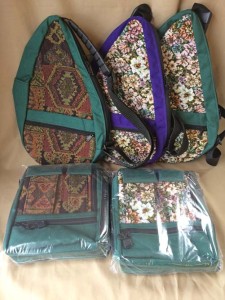Why You Want to Buy a Quality Bag: When you buy a cheap, not-well-made purse, the seam bursts open when you are shopping. When the seam of your bag bursts open, your car keys fall out and you lose them. When you lose your car keys, you stand in the parking lot unable to get into your car. When you are unable to open your car door, it inevitably rains and then pours. When it pours and the wind howls, a tornedo forms and the tornedo sirens go off. When the tornedo sirens go off, you seek the closest shelter. When you seek the closest shelter, you dive into a muddy ditch and wait for the tornedo to pass. Don’t dive into a muddy ditch to avoid a tornedo, BUY A QUALITY BAG!
Here’s what it takes to make a sturdy handbag:
1. Heavy-Weight, Industrial Sewing Machines. We have two Juki DU-141 Walking Foot machines, as well as a Brother Industrial 5-Thread Serger. I also have a home machine — a real nice Bernina — but it’s just too PUNY in relation to the Juki. I use the home machine for household mending … it never touches my bags.
2. Good Quality, Heavy-Weight Materials.
I buy only 1000-denier nylon Cordura to use as the base of most of our bags. “Cordura” is a Dupont Corporation product and is much better than “microfiber” or other knock-offs. It’s strong, holds its shape and wears and washes well.
Most accent fabrics/tapestries are not a strong as the nylon Cordura, so wherever we use the tapestry we line it to give it extra strength. Also, some tapestries are a looser weave than others, so we serge the edges of those so it will not fray or run.

- Aztec Tapestry with edges serged to add more stability
I sew only with Number 69 nylon thread. It’s strong stuff and you cannot break it with just your hands.
After researching the break strengths of the buckles, etc. I chose a supplier who is (unfortunately) more-expensive but sells better-quality hardware. And you’ll notice that our webbing is stiff when it’s new. There is a light-weight and a heavy-weight version of most webbing and the heavy-weight is stiff when it’s new.
I use only YKK zippers, mostly #5. Again, I researched brands and weights of zippers and these are the best that are made.
3. Going the Extra Mile with Sewing Techniques. I double-sew all the zippers, triple-sew all the intersections and bind all the seams. I back-tack often at the beginning of a seam so there is no chance of coming un-sewn (I’ve worn the paint off the back pedal!) If I run out of bobbin thread when top-stitching, I take out the entire seam and start again so that the top stitching is one complete line and there is no danger of coming undone. I have been sewing since high school when I took sewing lessons from a professional seamstress so I’ve had many many years to develop my skills.
We do all the work ourselves and can be sure of our quality that way.
4. Sturdiness Built Into the Design. Several of our patterns call for straps that are sewn down the side as opposed to fitting into a top seam where they might pull out. Our three Totes even have the straps sewn all the way around the bottom!
SO … BUY A QUALITY MKI BAG. Warning: Make sure you like the color … you’ll have it a looong time!



